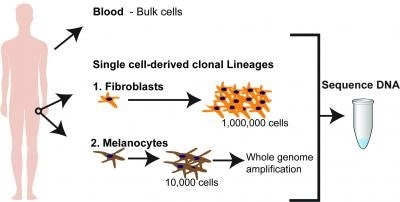For the first time, researchers have quantified the diverse types of genomic DNA variations that take place in skin cells and found that mutations from ultraviolet (UV) light is particularly common.

Schematics of the study design. From each donor, we obtained blood for whole-genome sequencing. In addition, we obtained skin biopsies from the hips of the donors from which fibroblasts and melanocyte clonal lineages were obtained. Fibroblasts were grown up to a million cells and their DNA was directly used for whole-genome sequencing, while melanocytes grew up to 10,000 cells and the DNA was whole-genome amplified and thereafter sequenced. Image Credit: Saini N et al., 2021, PLOS Genetics.
Dmitry Gordenin and collaborators from the National Institute of Environmental Health Sciences have published these findings in the PLOS Genetics journal on January 14th, 2021.
In human skin cells, the DNA experience damage from sources both within and outside the body, resulting in genomic modifications, like mutations that may result in the development of cancer.
While UV light is the main source of such mutations, by-products of cellular metabolisms, such as free radicals, and DNA copying errors that take place during the division of cells, also cause genomic modifications.
Although these mutation-causing mechanisms are widely known, no one had been able to precisely quantify the corresponding contributions from each source in the past.
In the recent article, Gordenin and his collaborators measured the quantities of each type of genomic modification by sequencing the genomes of skin cells obtained from 21 White and Black individuals, whose ages ranged between 25 and 79.
The team found that the total amount of genomic modifications from metabolic by-products builds up as an individual gets older, whereas the amount of genomic modifications induced by UV damage is not related to an individual’s age.
The researchers also demonstrated that genomic modifications from UV light is quite common, even in skin cells that are generally protected from the sun; however, it was less common in Black donors when compared to White donors.
The team believes that Black individuals are perhaps better protected from UV light because they have higher levels of the skin pigment melanin. Supporting this concept is the fact that Black individuals have relatively lower levels of skin cancer when compared to White counterparts.
On the whole, the new study gives a precise estimate of the genomic alterations that take place in skin cells because of different forms of DNA damage, and defines the standard range of somatic genomic changes across different races and a broad range of ages, thus giving a baseline for upcoming studies.
The new study provides an accurate estimate of the genomic changes that occur in skin cells due to different types of DNA damage, and establishes the normal range of somatic genomic changes across a wide range of ages and of different races, providing a baseline for future research.”
Study Authors
Source:
Journal reference:
Saini, N., et al. (2021) UV-exposure, endogenous DNA damage, and DNA replication errors shape the spectra of genome changes in human skin. PLOS Genetics. doi.org/10.1371/journal.pgen.1009302.